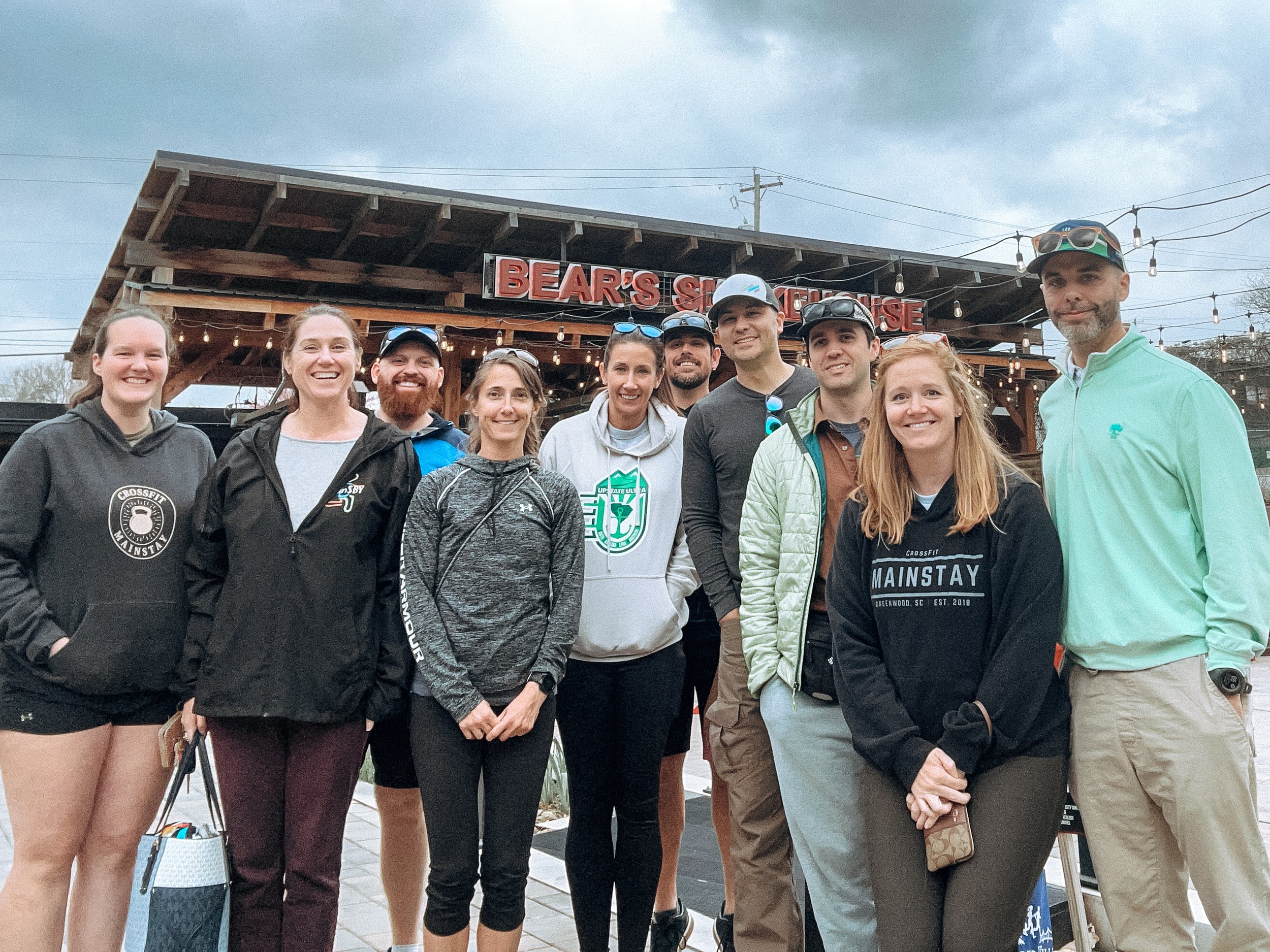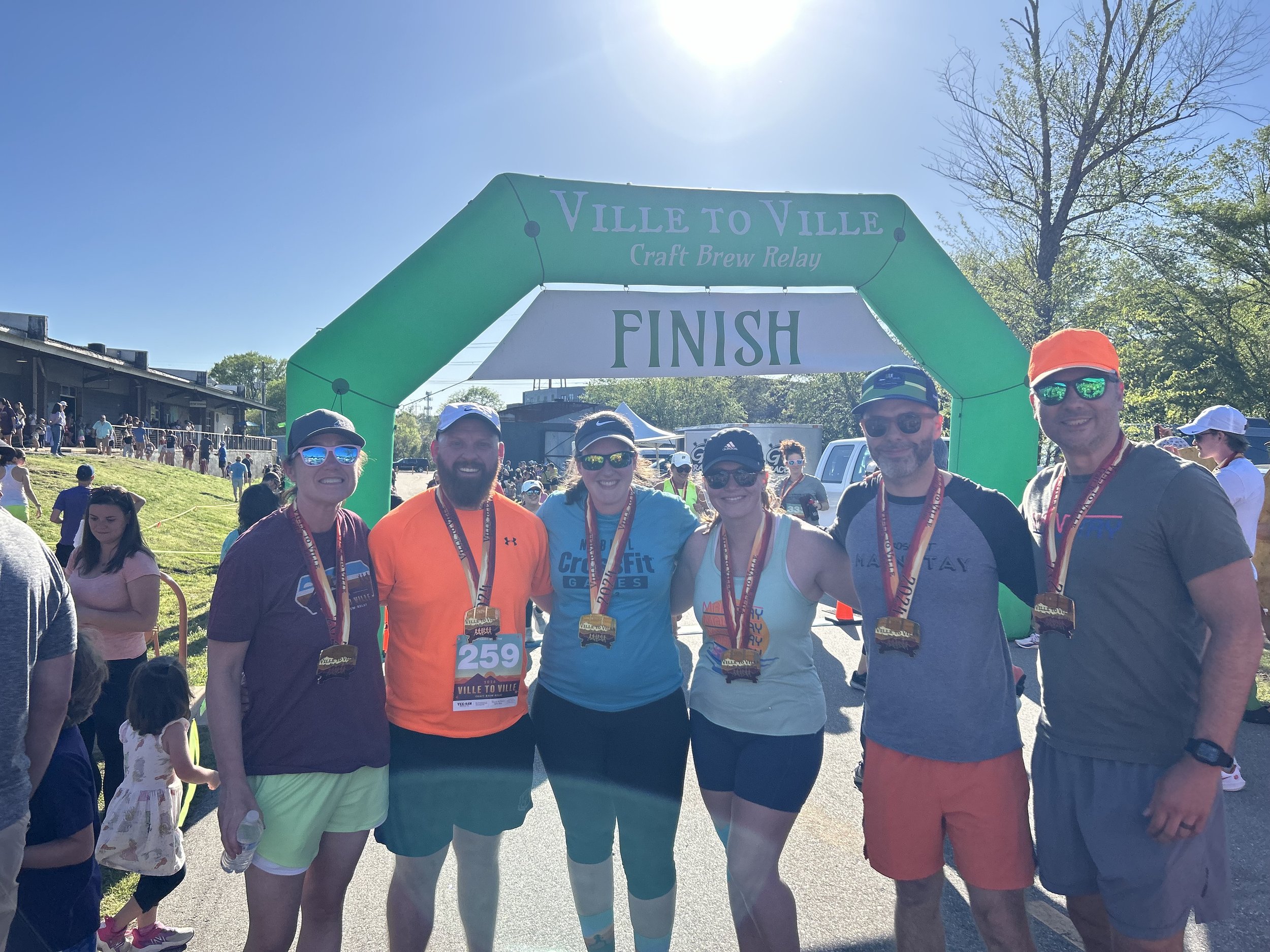How to Recover Post-Race
This weekend, 3 members of the Peak Performance team (as well as quite a few Peak athletes) had the opportunity to compete in a 72-mile team running relay that started in Asheville, NC and ended in Greenville, SC. Despite the fun that each of us had, we were reminded of how difficult it can be to recover post-race!
Races are a huge stressor on our bodies (despite being a ton of fun), and result in our glycogen stores in our muscles being depleted, dehydration, and a good bit of muscle damage that we have to repair in the coming days. Essentially, we dig ourselves a hole that we need to help ourselves out of in the coming days/weeks (depending on the duration and intensity of the race). Our goal post-race is to fill in that hole more quickly so that we can get back to feeling and performing our best a little faster than our competition!
A few things that we need to consider immediately post-race are: nutrition, hydration, rest, soft tissue mobility, controlling swelling, and active recovery.
Nutrition:
Calorie needs: even if you've been on a mission to lose weight, race week and the first few days post-race are not the days to be eating in a deficit. We need every bit of our daily calorie needs (plus a little bit) in the next 72 hours or so post-race to replenish our glycogen stores (our quick and easy energy source.)
Contents: We need to prioritize high quality proteins (bonus points if you include some meet off of the bone or bone broth to get that collagen in!), healthy fats, and a combination of some simple and complex carbs that are loaded with vitamins and minerals (bring on the fruits, veggies, and multigrain breads!) One post-race strategy that we like is to keep some whey protein on hand (either mixed with milk or a milk substitute in a shaker bottle or in an easy pre-made, store bought shake) to drink within the first 30 minutes post-race along with a simple carb like a banana. This allows our bodies to bounce back a little bit faster with muscle repair and to replenish a little bit of our glycogen stores.
Hydration:
Whether race conditions are hot or cold, it is almost impossible to take in enough liquids and salt to replenish what we sweat out in a race. There are a lot of factors that play into how much extra we need to drink, including: how hydrated we were pre-race, how hot and humid race conditions were, how much you sweat, whether you are a very salty sweater or not, and how much you peed during and post-race (as well as the color of our pee post-race). All of these factors make it virtually impossible for us to give specific guidance on how much we should drink post-race, so to keep it simple, we like to intentionally try to hydrate and supplement electrolytes more than usual for the first 48 hours post-race. Another strategy we like is to add a little extra salt to our foods post-race. This helps encourage us to drink and works to replenish some of the sodium we lost during the race.
Rest: Let's talk sleep!
Races provide a significant amount of stress to every system in our bodies, including our brain and nervous system. It is totally normal to see a drop in our sleep scores post-race (even with increased sleep duration) as well as worsened heart rate variability. Because of this, we need extra rest over the next few days to repair the damage and bounce back. Ideally, we want to stretch out our sleep duration at night to longer than our normal 8 hours of sleep, but we can also add in some naps, meditation, and deep breathing to help our nervous system downregulate and recover more quickly.
Soft tissue mobility:
We all know the feeling of extreme soreness after a hard effort. After a long or hard race, we accumulate a significant amount of tissue trauma (we also get this in training, but to a much lesser extent) in our muscles and the connective tissues surrounding them. One side effect of this is that all of those tissues tend to stick together, causing us to feel stiff, sore, and tender to the touch (also partly due to the lactic acid buildup). To help hedge this, we like to break out a foam roller, lacrosse ball, handheld roller, massage gun, or metal tool for scraping and do some self-massage to whatever feels the most sore and tight. We are not trying to break up any tissues, but we are trying to get those connective tissues sliding and gliding on each other again like they are meant to. There is no set amount of pressure we should apply, just do what you can tolerate. If you see any redness in the area you are working on (especially if scraping with a metal tool) or signs of bruising, that is your sign to move on to the next sore spot.
Controlling swelling:
Because of the soft tissue damage we do in a race, it is common to have some swelling (most commonly gravity causes it to pool in the feet/ankles). This can be present for 2-3 days post race for extra intense or longer races. This swelling is lymphatic fluid that pools as a result of cellular damage. The biggest issue with the lymphatic system is that it relies on the muscular system to flush out swelling, but if we are sore and less active, it is hard to do enough to pump this swelling out, so we like to help speed things up with compression (static or dynamic), and/or elevation. For compression, breaking out some compression socks (static compression) is a super easy way to help some of that lymphatic fluid drain with very little effort. If you have the means and want something that works more quickly, you can also buy a dynamic compression device like Normatec or a similar brand. These use graduated compression to pump out lymphatic fluid while you sit or lay down and chill out post-race. Another easy alternative is laying on the ground with your feet up on a wall. This allows you to use gravity to encourage the lymphatic fluid to flow out of your feet/ankles.
Active recovery:
The absolute worst thing that we can do in the days following a race is veg out on the couch all day. Our bodies need to move to recover! The more ways that we can find to add in some movement to our days, the better (minus naps, as needed!) Ideally, we want to do activities that allow us to get our heart rates up a little bit so that we increase the blood flow to our sore muscles and flush out any lactic acid and debris from cellular damage, but that are not so intense that they increase the damage to our muscular and nervous systems. These should be simple movements that don't require a ton of focus (think easy walks/jogs, biking, rowing, swimming) and are not very technical. Our nervous systems and muscles are still extremely fatigued, so this is not the time to try to master a new skill or work hard on technique. If we do any lifting, it should be light and easy. We also like to add in some extra stretches and movements that require a lot of range of motion, but limit the loading. After 2-3 days, we can slowly start ramping back up our training as we feel able, but the first few days post-race are definitely not for setting PRs! Our injury risk stays higher because our body is still repairing itself from the stresses of the race, meaning that our capacity for training is much lower for longer than we feel like it should be! However, the fitter and the higher our capacity we build up to (the stronger we are, the better our aerobic base, and the better our muscular endurance), the faster we are able to rebound from hard efforts like races!
Remember, the longer or the harder the effort as well as the older the athlete, the more time and effort we have to put into our recovery. All of these strategies can be used for both hard training days and for post-race recovery.
If you have done all of these things but still have a nagging ache or pain post-race, give us a call at Peak Performance! We can get down to the root cause of your pain and help you prevent it from returning in the future!





